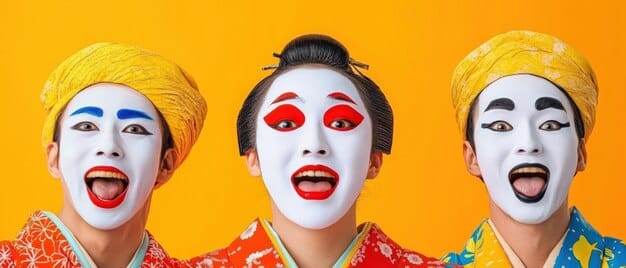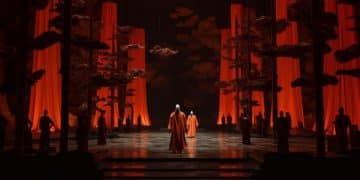Japanese Drama Character Archetypes: Tsundere, Yandere, and More

Advertisements
Japanese dramas, or J-dramas, are known for their unique character archetypes, such as the tsundere (cold on the outside, warm on the inside) and yandere (initially loving, but dangerously obsessive), which add depth and appeal to the storylines.
Japanese dramas, often called J-dramas, captivate audiences worldwide with their compelling stories and unique characters. But what makes these characters so memorable? It’s often their adherence to specific archetypes that viewers recognize and love. Let’s delve into the fascinating world of Japanese drama character archetypes, exploring the tsundere, yandere, and many more nuanced personalities that bring these stories to life.
Anúncios
Understanding J-Drama Archetypes
Character archetypes are recurring patterns of behavior, personality traits, and motivations that are instantly recognizable. In J-dramas, these archetypes provide a shorthand for writers to quickly establish a character’s role and appeal in the story. Understanding these archetypes allows viewers to delve deeper into the themes and narratives presented, enhancing the overall viewing experience.
What Makes an Archetype?
An archetype is more than just a stereotype; it’s a foundational blueprint upon which individual characters are built. Archetypes are universal, appearing across different cultures and narratives, making them easily relatable. Think of them as a starting point that writers can then personalize with unique quirks and backstories.
Anúncios
Why Are Archetypes Important in Storytelling?
Archetypes provide several critical functions in storytelling:
- Familiarity: They offer viewers a sense of familiarity, making it easier to connect with new characters.
- Efficiency: They allow writers to convey complex information quickly, focusing on character development.
- Theme Exploration: They provide a framework for exploring deeper themes and societal values.
Ultimately, J-drama archetypes provide a rich tapestry of familiar yet unique characters that continue to draw audiences in.

The Classic Tsundere: Cold Outside, Soft Inside
One of the most beloved and enduring archetypes in Japanese dramas is the tsundere. This character is characterized by their initially cold, hostile, or aloof exterior, which gradually melts away to reveal a warm, caring, and vulnerable interior. The tsundere’s charm lies in this contrast, making their eventual affection all the more rewarding.
Key Traits of a Tsundere
A tsundere isn’t just someone who is mean; they often have underlying insecurities or past traumas that cause them to put up emotional walls. Here are some key traits:
- Initially hostile or cold demeanor
- Difficulty expressing emotions openly
- Secretly kind and caring
- Becomes flustered when their true feelings are revealed
The appeal of the tsundere stems from the slow burn of their character development, as viewers eagerly anticipate their eventual display of affection.
The gradual reveal of the tsundere’s hidden warmth creates a compelling narrative arc, making them a memorable and beloved character type.
The Enigmatic Yandere: Love to Obsession
In stark contrast to the tsundere, the yandere presents a more complicated and often dangerous archetype. Initially sweet, kind, and loving, the yandere is characterized by their extreme, obsessive devotion to the object of their affection. This obsession can manifest in disturbing ways, including violence, stalking, and possessiveness.
Understanding the Yandere’s Dark Side
The yandere’s actions are driven by a deep-seated fear of abandonment and a distorted perception of love. They believe that controlling and isolating their beloved is the only way to protect them from harm.
- Initially sweet and innocent demeanor
- Extreme, obsessive devotion
- Propensity for violence and manipulation
- Driven by fear of abandonment
Why the Yandere is so Captivating
Despite their disturbing tendencies, the yandere remains a captivating character type. Their complex motivations and unpredictable behavior create a sense of suspense and intrigue, forcing viewers to question the boundaries of love and obsession.
Ultimately, the yandere serves as a cautionary tale about the dangers of unchecked obsession and the destructive nature of possessiveness.

Hikikomori: The Socially Reclusive
The hikikomori archetype reflects a growing social phenomenon in Japan: extreme social withdrawal. These characters isolate themselves from society, often remaining confined to their homes for months or even years. J-dramas often explore the underlying causes of this behavior, such as social anxiety, academic pressure, or family dysfunction.
Exploring the Roots of Hikikomori
Hikikomori are not simply lazy or antisocial; they often struggle with deep-seated insecurities and fears. J-dramas delve into the emotional turmoil that drives these characters to withdraw from the world.
Common Characteristics of a Hikikomori
- Extreme social withdrawal
- Confined to their home for extended periods
- Struggles with social anxiety and depression
- Often escapes into virtual worlds or hobbies
Through the portrayal of hikikomori, J-dramas offer a glimpse into the challenges of modern society and the importance of social connection.
By humanizing the hikikomori archetype, J-dramas encourage empathy and understanding for those struggling with social isolation.
The Genki Girl: Infectious Energy and Optimism
The genki girl is a vibrant and energetic character who brings a burst of optimism and enthusiasm to any situation. They are often portrayed as quirky, cheerful, and relentlessly positive, inspiring those around them with their infectious spirit.
The Power of Positivity
Genki girls often serve as a counterpoint to the darker, more cynical characters in J-dramas. Their unwavering optimism acts as a catalyst for change, encouraging others to overcome their challenges.
Key Traits of a Genki Girl
- Unwavering optimism and energy
- Cheerful and outgoing personality
- Quirky and often eccentric
- Inspires others with their positivity
The genki girl archetype reminds viewers of the importance of maintaining a positive outlook, even in the face of adversity.
Ultimately, the genki girl embodies the power of optimism and the ability to find joy in even the most challenging circumstances.
The Ojou-sama: Privileged and Refined
The ojou-sama archetype represents the epitome of wealth, privilege, and refinement. These characters are typically born into affluent families, educated in prestigious schools, and groomed to embody the ideals of grace and elegance. However, beneath their polished exterior, ojou-sama often grapple with unique challenges and expectations.
The Complexities of Privilege
While ojou-sama may appear to have it all, J-dramas often explore the pressures and limitations that come with their privileged status. They may struggle with arranged marriages, societal expectations, or a lack of genuine connection.
Common Characteristics of an Ojou-sama
- Wealthy and privileged background
- Highly educated and refined
- Subject to societal expectations and arranged marriages
- May struggle with loneliness or lack of autonomy
Through the portrayal of ojou-sama, J-dramas explore themes of class, societal expectations, and the search for personal fulfillment beyond material wealth.
The ojou-sama archetype serves as a reminder that true happiness cannot be bought and that even those who appear to have everything can experience unique challenges and vulnerabilities.
The “Office Lady” (OL): Navigating Workplace Dynamics
The “Office Lady,” or OL, is a prevalent archetype in Japanese dramas, representing the everyday working woman navigating the complexities of Japanese corporate culture. These characters often face challenges related to gender inequality, workplace harassment, and the pressure to conform to traditional roles.
Realities of the Japanese Workplace
OL characters provide a window into the realities of the Japanese workplace, highlighting both the positive aspects of teamwork and dedication and the negative aspects of overwork and discrimination.
Typical Characteristics of an OL
- Dedicated and hardworking
- Faces gender inequality in the workplace
- Subject to workplace hierarchy and expectations
- Often seeks personal fulfillment outside of work
J-dramas featuring OL characters often tackle relevant social issues, sparking discussions about gender equality and work-life balance in Japan.
The OL archetype resonates with viewers who can relate to the challenges and triumphs of navigating a demanding work environment.
| Key Archetype | Brief Description |
|---|---|
| 🎭 Tsundere | Initially cold, reveals a kind and caring side. |
| 💔 Yandere | Sweet initially, becomes obsessive and potentially violent. |
| 🏠 Hikikomori | Extremely socially withdrawn, stays home for long periods. |
| 🌟 Genki Girl | Energetic, optimistic, and inspires others. |
Frequently Asked Questions (FAQ)
▼
A character archetype is a recurring pattern of personality traits, behaviors, and motivations that are easily recognizable across different stories and cultures. They provide a template for quickly understanding a character’s role.
▼
Tsundere characters are popular because their gradual softening and reveal of hidden kindness is satisfying to watch. The contrast between their initial coldness and later warmth makes their affection feel earned and special.
▼
While the yandere archetype is often portrayed negatively due to their obsessive and violent tendencies, some stories explore the character’s motivations with more nuance, delving into their traumatic pasts to understand their extreme behavior.
▼
OL characters often reflect issues like gender inequality in the workplace, the pressure to conform to traditional roles, and the challenges of achieving work-life balance in demanding corporate environments in Japan.
▼
J-dramas use hikikomori characters to explore themes of social isolation, anxiety, and the pressures of modern society. They often depict the struggles and underlying causes that lead to extreme social withdrawal.
Conclusion
Japanese dramas offer a rich and diverse range of character archetypes, each with their own unique appeal and complexities. From the endearing tsundere to the enigmatic yandere, these archetypes provide a framework for exploring universal themes of love, loss, identity, and societal pressures. By understanding these recurring character patterns, viewers can gain a deeper appreciation for the storytelling techniques employed in J-dramas and the cultural values they reflect.





